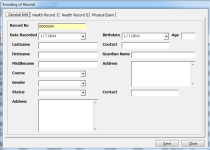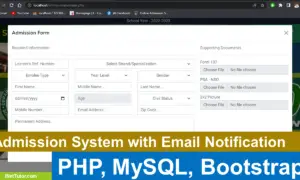Blood Pressure and Blood Sugar Information System
Introduction
Table of Contents
Monitoring blood pressure and blood sugar levels is crucial for maintaining good health, especially for individuals with conditions like hypertension or diabetes. Regular tracking of these metrics helps in early detection of potential health issues, allowing for timely intervention and better management of overall well-being.
In today’s digital age, technology plays a significant role in managing health data. With the help of a well-designed information system, users can easily log, track, and analyze their blood pressure and blood sugar levels, leading to more informed health decisions.
PHP and MySQL are powerful tools for building such an information system. PHP is a popular server-side scripting language that allows developers to create dynamic web applications, while MySQL is a reliable database management system that stores and organizes data efficiently. Together, they provide a robust platform for developing a Blood Pressure and Blood Sugar Information System, making it easier for users to monitor their health from anywhere, at any time.
Healthcare Management System with Online Appointment and Payment
Why a Blood Pressure and Blood Sugar Information System?
Having a centralized system for tracking vital signs like blood pressure and blood sugar offers numerous benefits that can significantly enhance health management.
Accuracy and Consistency of Data
A dedicated information system ensures that all health data is recorded accurately and consistently. This is crucial because even small errors in measurement can lead to incorrect conclusions about a person’s health. By using a digital system, users can minimize human error and ensure that their readings are reliable, which is essential for effective health monitoring.
Easy Access to Health Records
With a centralized system, individuals can easily access their health records anytime and anywhere. This convenience allows users to review their historical data, making it simpler to share information with healthcare providers during appointments. Having all health data in one place can streamline communication and improve the quality of care received
Ability to Identify Trends and Patterns
Tracking blood pressure and blood sugar levels over time helps users identify trends and patterns in their health. For instance, they may notice how their readings fluctuate in response to diet, exercise, or medication changes. Recognizing these patterns can empower individuals to make informed lifestyle choices and adjustments to their treatment plans.
Improved Health Management
Ultimately, a blood pressure and blood sugar information system enhances overall health management. By providing users with tools to monitor their vital signs effectively, they can take proactive steps to maintain their health. This can lead to better outcomes, such as preventing complications related to high blood pressure or diabetes, and fostering a more engaged approach to personal health.
System Features
A Blood Pressure and Blood Sugar Information System offers a range of features designed to help users effectively monitor and manage their health. Here’s a look at the key features:
- Data Entry
The system allows users to easily input their blood pressure and blood sugar readings. Users can log their measurements daily or as needed, ensuring that all their health data is recorded in one place. This feature is user-friendly, making it simple to enter readings quickly and accurately.
- Data Visualization
Visualizing health data is crucial for understanding trends and making informed decisions. The system includes charts and graphs that display blood pressure and blood sugar levels over time. These visual tools make it easier to identify patterns, track progress, and spot any irregularities that may require attention.
- Alerts and Notifications
To help users stay on top of their health, the system includes alerts and notifications. Users can set reminders for regular monitoring, ensuring that they never miss a reading. Additionally, the system can send alerts if a reading falls outside of a normal range, prompting users to take action or seek medical advice.
- User Management
The system supports multiple user accounts, each with its own set of permissions. This feature is particularly useful for families or healthcare providers who need to manage multiple users’ data. Each user can securely log in to their account, ensuring that their health data is private and accessible only to them or authorized individuals.
- Integration with Other Health Devices (Optional)
For users who rely on wearable devices or glucose meters, the system can be enhanced with integration capabilities. This feature allows the system to automatically sync data from these devices, eliminating the need for manual data entry. By connecting with other health devices, the system becomes even more powerful, providing a comprehensive view of the user’s health metrics.
System Architecture
A well-designed Blood Pressure and Blood Sugar Information System consists of several key components that work together to provide a seamless experience for users. Let’s break down the basic architecture:
- Frontend: User Interface for Data Entry and Visualization
The frontend is what users interact with directly. It includes:
- Data Entry Forms: Simple and intuitive forms where users can input their blood pressure and blood sugar readings.
- Dashboards: A visual display of the user’s health data, including charts and graphs that show trends over time.
- Alerts and Notifications: Interface elements that notify users of upcoming readings, abnormal measurements, or important health reminders.
The frontend is typically built using HTML, CSS, and JavaScript, which work together to create a responsive and user-friendly interface. These technologies ensure that the system is accessible on various devices, from desktops to smartphones.
- Backend: Database and Server-Side Logic
The backend is the engine that powers the system, managing data storage, processing, and security. It includes:
- Database: MySQL is used to store all user data securely, including blood pressure and blood sugar readings, user profiles, and any other relevant information.
- Server-Side Logic: PHP handles the server-side operations, such as processing data entered by users, authenticating users, generating reports, and managing alerts.
The backend ensures that the system runs smoothly, processes user requests, and securely stores data. It acts as the bridge between the user interface and the data stored in the database.
Why Use PHP and MySQL?
Advantages of PHP for Web Development
- Simplicity and Flexibility: PHP is easy to learn and use, making it an ideal choice for building web applications like this system. It’s flexible enough to handle various tasks, from simple form processing to complex data management.
- Wide Support and Community: PHP has a large and active community, meaning there are plenty of resources, tutorials, and frameworks available to help developers.
- Compatibility: PHP integrates seamlessly with MySQL, which makes it a powerful combination for developing data-driven web applications.
Advantages of MySQL for Data Management
- Reliability: MySQL is a well-established and reliable database management system, ensuring that user data is stored safely and can be accessed whenever needed.
- Performance: MySQL is optimized for performance, making it capable of handling large amounts of data efficiently, which is crucial for a system that needs to store frequent health readings.
- Scalability: Whether you’re building a small personal health tracker or a large-scale system for multiple users, MySQL can scale to meet the needs of the application.
Specific Use Cases within the System
- Data Storage: MySQL stores all the health readings, user profiles, and other data, ensuring it is easily retrievable and organized.
- User Authentication: PHP handles user login and registration processes, ensuring that only authorized users can access the system.
- Data Processing: PHP scripts process the data entered by users, calculate trends, and trigger alerts when necessary.
Conclusion
In summary, the Blood Pressure and Blood Sugar Information System offers a powerful and convenient way to monitor vital health metrics. By providing a centralized platform for data entry, visualization, and alerts, the system helps users maintain accurate and consistent records of their blood pressure and blood sugar levels. With easy access to this data, users can identify trends, receive timely alerts, and make informed decisions about their health, ultimately leading to better health management and outcomes.
The use of PHP and MySQL in this system ensures that it is not only efficient but also scalable and secure. These technologies allow for the creation of a responsive and user-friendly interface while ensuring that all data is stored safely and processed effectively.
If you’re interested in exploring this system further or considering building a similar application, now is the perfect time to start. Whether you’re a developer looking to expand your skills or someone passionate about health management, creating or using a system like this can be a valuable step toward better health and well-being.
By taking advantage of the tools and features available in a Blood Pressure and Blood Sugar Information System, you can stay proactive in managing your health and help others do the same.
Readers are also interested in:
List of 45 Best Nursing and Health Related IT Capstone Project
You may visit our Facebook page for more information, inquiries, and comments. Please subscribe also to our YouTube Channel to receive free capstone projects resources and computer programming tutorials.
Hire our team to do the project.


